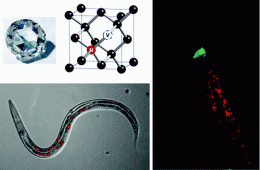September 9, 2010 report
Nanodiamonds could be used in disease diagnosis

(PhysOrg.com) -- Scientists in Taiwan have developed fluorescent nanodiamonds that may in the future be used in the diagnosis and treatment of human disease.
Nanodiamonds are fluorescent carbon nanoparticles bonded together to form a nano-scale diamond. (One hundred thousand nanometers is about the width of a human hair.) They were originally developed for the surface finishing industry, but they have been shown to have a number of unique features that make long-term tracking in living cells practical, including photostability and lack of fluorescence blinking.
Like ordinary diamonds, nanodiamonds have tiny holes, known as vacancies, in which a nitrogen atom has replaced a carbon. A high nitrogen content gives natural diamonds a yellowish tint, and the nanodiamonds absorb yellow light and emit violet.
The researchers, Yi-Chun Wu, Huan-Cheng Chang, and colleagues, coated some nanodiamonds with sugars or proteins (such as dextran and bovine serum albumin), and then introduced both coated and uncoated types to transparent round worms (Caenorhabditis elegans). The nanodiamonds were either fed to the worms as a colloidal suspension or micro-injected into the gonads.
They found the plain nanodiamonds fed to the worms remained within the digestive tract, coating its internal surfaces, while the coated nanodiamonds were able to pass through the tract walls and into the worm’s body, collecting at several points. The location of the nanodiamonds was shown up as violet light when yellow light was shone on the worms.
When injected into the gonads, the nanodiamonds were dispersed in the gonad and passed on to the embryos and eventually to the hatched larvae.
The researchers say their work showed nanodiamonds were safe, stable, and non-toxic at cellular and organ levels. All the worms in the study went on to live normal lifespans with normal reproduction, and none showed any sign of distress.
The nanodiamonds in the study were coated with sugars or proteins, but the scientists said almost any form of chemical could be used to coat them. The coated nanodiamonds could then migrate to target cells such as pathogens, immune system cells or cancer cells. This process could initially be used to map out cancers or other disease conditions, but could eventually be used to deliver low doses of drugs directly to the target tissues.
Dr. Chang said another application for the nanodiamonds could be for imaging and tracking human stem cells that might even be able to regenerate entire organs if the research is successful.
The paper is published in the journal Nano Letters.
More information: In Vivo Imaging and Toxicity Assessments of Fluorescent Nanodiamonds in Caenorhabditis elegans, Nitin Mohan, Chao-Sheng Chen, Hsiao-Han Hsieh, Yi-Chun Wu and Huan-Cheng Chang, Nano Lett., (2010) pubs.acs.org/doi/abs/10.1021/nl1021909
© 2010 PhysOrg.com













